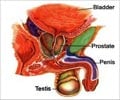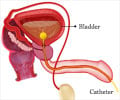About Benign Prostatic Hyperplasia
Benign Prostatic Hyperplasia (BPH) is a common urological condition caused by the non-cancerous enlargement of the prostate gland.
The word ‘benign’ means that the enlargement is not caused by cancer or infection. The word ‘hyperplasia’ means enlargement. It is also known as Benign Enlargement of Prostate (BEP).
The prostate is a walnut sized gland that is part of the male reproductive system. It is located below the urinary bladder and surrounds the upper portion of the urethra (the tube that carries urine out of the body). The main function of the prostate gland is to produce fluid for the semen.
As the prostate gland increases in size it causes the gland to pinch against the urethra like a clamp on a garden-hose. As a result it can put pressure on the urethra and slow down or cut off the flow of urine. The bladder wall becomes thicker and irritable leading to contraction of bladder even when it contains small amounts of urine, causing more frequent urination. Eventually, the bladder weakens and loses the ability to empty itself.
The size of the prostate does not always determine how severe the obstruction or the symptoms will be. Some men with greatly enlarged glands have little obstruction and few symptoms while others whose glands are less enlarged, have more blockage and greater problems. Sometimes a man may not know that he has any obstruction until he suddenly finds that he is unable pass urine at all.
A variety of treatment approaches can help solve BPH problems. To provide relief from BPH symptoms, medications may be needed to relax the muscles of the prostate, or to block hormones that cause prostatic growth, or to relax the bladder and improve continence. Surgery is recommended for people who have not been able to successfully treat the condition with other treatment options.
Causes of Benign Prostatic Hyperplasia
The exact cause of BPH is not entirely clear but ageing and hormonal changes appear to play an important role.
It is a well known fact that BPH occurs mainly in older men and that it does not develop in men whose testes were removed before puberty.
Men produce testosterone (male hormone) and small amounts of estrogen (female hormone). The amount of active testosterone in the blood decreases with increasing age, leaving a higher proportion of estrogen. Animal studies have suggested that BPH may occur because the higher amount of estrogen within the gland increases the activity of substances that promote cell growth.
Another theory focuses on dihydrotestosterone (DHT). DHT is a substance derived from testosterone in the prostate, which may help in controlling its growth. Most animals lose the ability to produce DHT as they age. Research has shown that men who do not produce DHT do not develop BPH.
Risk Factors for developing BPH include-
- Ageing
- Obesity
- Lack of physical activity
- Erectile dysfunction
- Family history of BPH
Symptoms of Benign Prostatic Hyperplasia
Since the prostate is just below the urinary bladder, its enlargement can result in symptoms that irritate or obstruct the bladder. Common symptoms of BPH include-
- Weak urine stream.
- Dribbling after urination.
- Frequent urination, particularly at night (i.e. nocturia).
- Feeling of incomplete emptying of the bladder.
- Hesitancy - leakage of urine (i.e. overflow incontinence).
- Inability to postpone urination once there is an urge to urinate
- Straining or pushing to begin urination.
- Blood in the urine (i.e. hematuria) caused by straining.
Diagnosis of Benign Prostatic Hyperplasia
When a doctor evaluates someone for possible BPH, the evaluation typically consists of a thorough medical history, urinalysis (an examination of the urinary sediment), a physical examination (including a digital rectal exam or DRE), and use of the AUA BPH Symptom Score Index.
AUA BPH Symptom Score Index-
The American Urological Association (AUA) has developed an AUA BPH Symptom Score Index to help assess the severity of BPH symptoms, ranging from mild to severe.
Physical Examination-
A physical examination helps the doctor evaluate the patient’s general health. Digital Rectal Examination (DRE) is usually the first test done. The doctor assesses the size and condition of the prostate gland by inserting a gloved finger into the rectum and feeling the part of the prostate next to the rectum.
Laboratory Investigations-
Uroflometry / Urine Flow Study- The doctor may ask the patient to urinate into a special device that measures how quickly the urine is flowing. A reduced urine flow often suggests BPH.
Ultrasound of Kidney, ureter and bladder- This is a non-invasive test that helps in determining the size of the prostate gland and if there is any residual urine left after a person has voided (also called post-void residual volume or PVR). A look at the kidney by the ultrasound probe would indicate if there is a blockage due to the enlarged gland causing swelling or hydro-nephrosis. The test should be done on a full bladder.

Urine investigations- Routine urine and/or a urine culture are done to rule out urinary tract infection.
PSA (Prostate specific antigen) blood test is used to detect abnormally high levels of a protein substance in the blood that may indicate prostate cancer.
Cystoscopy- Cystoscopy allows the doctor to determine the size of the gland and identify the location and degree of the obstruction.
Ultrasound of the kidney or the prostate is done to view the enlargement.
Urodynamic pressure-flow study- It tests the pressures inside the bladder during urination, however this is rarely indicated. It is usually advised if there is a redo surgery or the symptoms are predominantly indicating irritation and bladder overactivity or there is large residual urine indicating a poorly contracting bladder.
Treatment of Benign Prostatic Hyperplasia
The treatment of BPH involves the following-
Watchful Waiting-
This treatment option is good for patients who have mild symptoms of BPH and are not bothered by their symptoms. During watchful waiting, a patient is closely monitored by the urologist but does not receive any active treatment. Yearly check-ups and findings from the tests help determine if additional treatment is needed in order to control a patient’s BPH.
Medical Therapies-
Alpha blockers like alfuzosin, terazosin, doxazosin or tamsulosin work by relaxing the smooth muscle of the prostate and bladder to improve urine flow and reduce bladder outlet obstruction. Although they may relieve the symptoms of BPH, they usually do not reduce the size of the prostate.
5-alpha-reductase inhibitors like finasteride and dutasteride can relieve BPH symptoms, increase urinary flow rate and shrink the prostate though it must be used indefinitely to prevent symptoms. These drugs also reduce the risk of BPH complications.
Combination Therapy- The use of both alpha blockers and 5-alpha-reductase inhibitors prevents the progression of disease and improves bothersome symptoms.
Surgery-
Surgery is reserved for patients suffering from moderate to severe complications which arise from BPH (e.g. urinary retention or recurrent urine infection), and who have not been able to successfully treat the condition with other treatment options. There are two types of surgery to remove excess prostate tissue-
Trans-urethral resection of prostate (TURP) - This is an endoscopic procedure and usually a spinal or epidural anesthesia may be given for this surgery. It is the most common type of surgery undertaken for an enlarged prostate gland. During this procedure an instrument is inserted through the penis to allow the doctor to see and remove any tissue blocking the urinary passage called the urethra.
Open prostatectomy- May be done when a large amount of tissue must be removed or when the size, shape or position of the prostate makes it necessary. An incision is made in the abdomen or the area between the anus and scrotum and the excess tissue is removed.















